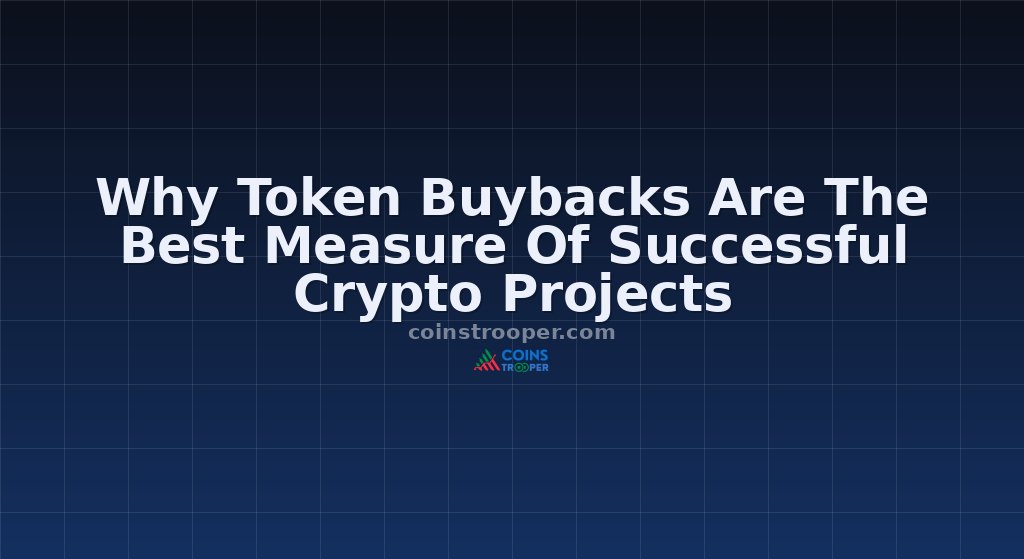Why Token Buybacks Are The Best Measure Of Successful Crypto Projects

- For years, crypto projects have launched tokens, often in the name of governance or network security.
- With this model, token holders have the right to vote on proposals and guide the future of a project in the spirit of decentralization.
- Yet oftentimes, these tokens are hardly doing anything meaningful for the value of a project.
- And it’s probably an outdated way to think about issuing cryptocurrencies in 2025.
What Happened
For years, crypto projects have launched tokens, often in the name of governance or network security. With this model, token holders have the right to vote on proposals and guide the future of a project in the spirit of decentralization.
Tons of blockchain projects have launched tokens – even if having a cryptocurrency wasn’t necessarily core to its focus.
Many projects launch tokens in the spirit of enhancing decentralization or to give the community associated with it a voice – noble efforts to increase distribution and participation.
Originally called Binance Coin and launched in 2017 during the height of the Ethereum ICO era, BNB was initally an Ethereum ERC-20 token.
At its outset, BNB developers had utility in mind. That’s why it performed different from most cryptocurrencies – an outlier when launched in 2017.
While Hyperliquid is facing competition from Binance-backed Aster DEX and others, its token has still held up well, with an over 500% appreciation since launch.
The memecoin launchpad Pump.fun, which conducted an ICO over the summer, raising $500 million, is another example of buybacks serving the project well.
Market Context
Yet oftentimes, these tokens are hardly doing anything meaningful for the value of a project. And it’s probably an outdated way to think about issuing cryptocurrencies in 2025. Recent market activities make it clear that tokens need some kind of utility and buyback/burn strategy to create value.
From exchange users getting a 25% discount on trading fees on Binance to dust conversion from smaller untradable amounts of crypto into BNB, the token has real use in its own ecosystem.
Binance burns BNB based on the exchange’s trading volumes. According to BNBBurn.info, over 62 million BNB has been burned out of an original circulation of 202 million, which is a 31% reduction in its overall supply.
Utility and burns have likely helped BNB to a record-high in terms of price of the token, hitting $1,000 in September.
Why It Matters
However, this can also result in community quagmires. One recent example of this comes from Across protocol. An affiliated entity of the project, Risk Labs, reportedly manipulated its DAO governance to take $23 million in tokens to fund future operations.
Risk Labs’ CEO Hart Lambur refuted any claims of manipulation with colorfully-titled Twitter/X article, claiming the accusations were motivated by a competitor.
Regardless of who’s right or wrong in this case, it highlights the fact that perhaps the DAO model may be outdated.
Details
Flaws in the Spirit of Decentralization
There are certainly underlying business reasons for this. This includes the fact that tokens when initially listed on exchanges can have serious upside value.
The Pioneer is BNB?
Despite many controversies, Binance’s BNB standsout as a model of utility.
In 2019, BNB was migrated over to the Binance Smart Chain platform.
HYPE and PUMP Following BNB Model
There are other crypto projects that are clearly taking heed from the success of BNB.
Hyperliquid, the perpetual and spot decentralized exchange built on its own blockchain and EVM-compliant smart contract system called HyperEVM, also burns its tokens.
The HYPE cryptocurrency is the only way to pay for platform fees, and are automatically burned.
Pump.fun has been a huge moneymaker in crypto, generating over $800 million in fees as traders FOMO into various memecoins on the platform.

